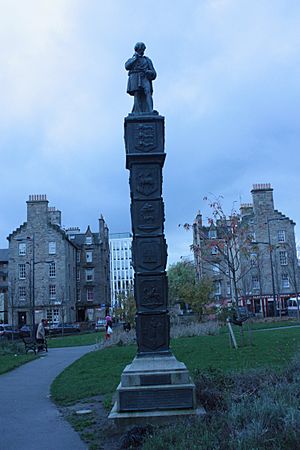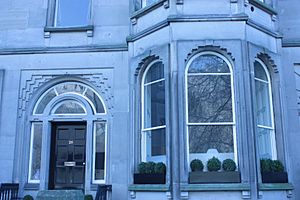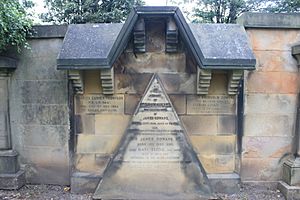James Gowans (architect) facts for kids
Sir James Gowans (born August 1, 1821 – died June 25, 1890) was a famous architect and builder from Edinburgh, Scotland. He was known for his unique building style, often using many different types of stone in one building. He also played a big part in building railways across Scotland.
Contents
Life of a Master Builder
James Gowans was born in Blackness, near Linlithgow. His father, Walter Gowans, was also a mason (a person who works with stone). James learned his skills from the Edinburgh architect David Bryce.
In 1848, James married Elizabeth Mitchell. After she passed away in 1858, he married Mary Brodie, whose father, William Brodie, was a sculptor. James built a special house called "Rockville" for them to live in. This house was one of his most amazing creations.
Challenges and Achievements
In 1875, James faced money problems because he invested a lot in a new theatre in Edinburgh. He had to sell it later for much less than it cost to build.
Despite this, he became Edinburgh's Lord Dean of Guild in 1885. This was an important job where he oversaw building projects. He also helped organize a big event called the International Exhibition of Industry, Science and Art in 1886. This exhibition showed off new inventions and art.
Because of his great work, Queen Victoria made him a knight in 1887. This meant he was given the title "Sir." He was very involved in building railways. He was famous for using many different types of stone in his buildings, making them look very unique.
Sadly, he faced more financial difficulties in 1888. He had to sell his amazing home, Rockville. He then moved to a smaller house where he later passed away. Sir James Gowans is buried with his first wife in Grange Cemetery in Edinburgh. His grave has his special design.
Gowans' Unique Homes
James Gowans often lived in the buildings he designed and built himself. It was almost like he received a house as part of his payment. Here are some of the places he called home:
- Gowanbank, his family home near Armadale.
- 1 Randolph Cliff, Edinburgh, which he built.
- 34 Rosebank Cottages, Edinburgh, another home he built.
- "Rockville" on Napier Road, Edinburgh, his most famous home, which he designed just for himself.
- 1 Blantyre Terrace, where he lived at the end of his life.
Rockville: The Crazy Manor
Rockville was a very unusual house in Edinburgh. People called it names like "The Pagoda," "The Chinese House," "Tottering Towers," and "Crazy Manor." It looked like something out of a fairy tale, with a tall, five-story tower that had a viewing platform.
Every window and chimney on the house was different and highly decorated. Even its small gate lodge looked like a house from "Hansel and Gretel." Both the house and the lodge used stones from almost every quarry in Scotland, plus some from China! It truly looked like a building from a Gothic novel.
Inside, Rockville had fancy gas lighting and beautiful decorations. James Gowans believed his design was practical and beautiful, not just fancy. The house sat on a large piece of land filled with statues made by his father-in-law, William Brodie.
Sadly, Rockville was torn down in 1966, even after many people signed a petition to save it. Today, only its boundary wall and some gateposts remain. However, one statue from the house, called "The Genius of Architecture," can now be seen in West Princes Street Gardens.
Gowanbank: A Family Remodel
Between 1842 and 1862, James Gowans updated his father's old farmhouse, Gowanbank, near Armadale. He made it much bigger and changed its look completely. He added unique stone details, tall chimneys, and used different types of stone that changed gradually across the building.
The farm buildings, like the cartshed and dairy, showed off his more developed style. They had varied, colorful stones and unique chimney designs. An interesting Bible verse was carved above the kitchen range: "For every house is builded by some man; but he that built all things is God." This showed his belief that God was the ultimate builder.
Over time, the farm became less active. In the 1990s, the house and farm buildings were restored and turned into several new homes.
Key Projects by Sir James Gowans
Sir James Gowans worked on many different types of projects during his career. Here are some of his notable works:
- Building of Randolph Cliff and part of Randolph Crescent in Edinburgh (1846).
- Railway contract for the Edinburgh to North Berwick section of the North British line (1847–1850).
- The base for Sir John Steell's statue of the Duke of Wellington in Edinburgh (1852).
- Rosebank Cottages, Edinburgh (1854), where he lived for a time.
- Re-erection of a statue to the Duke of Wellington in Falkirk (1854).
- Rockville on Napier Road, his own house (1858), which was later demolished.
- Monuments for his father and first wife in cemeteries (1859).
- Workmen's houses in Crieff (1859).
- Lammerburn on Napier Road (1860), a smaller version of Rockville.
- Railway contracts for sections of the Dundee to Newtyle Railway (1859–1861) and the Portpatrick Railway (1859).
- Rebuilding of Gowanbank, his father's house near Armadale (1862).
- "Pineapple tenement" at Castle Terrace/Cornwall Street, Edinburgh (1866).
- School and schoolhouse at Kingscavil, West Lothian (1870).
- Laying of tracks for the Edinburgh Corporation Tramways between Edinburgh and Leith (1871).
- New Edinburgh Theatre, Castle Terrace (1875), which later became the Synod Hall.
- Waverley House (82 Colinton Road, Edinburgh) for the penmaker Duncan Cameron (1884).
- The Brass Founders' Pillar for the Edinburgh International Exhibition (1886). This column, with a figure by John Stevenson Rhind, was later moved to Nicolson Square.
 The Brass Founders' Pillar from the Edinburgh International Exhibition
The Brass Founders' Pillar from the Edinburgh International Exhibition - Model houses for the Edinburgh International Exhibition (1886), later moved to Colinton Road.
- Masons pillars and a sundial for the Edinburgh International Exhibition (1886), which are still on The Meadows today.




